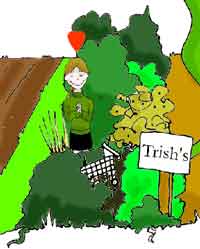June is one of the few times I like being English. It is a time for strawberries and cream, Wimbledon, the Glastonbury festival and weekend pagans drinking heavily at their local standing stones. It is a month where you want the rain for your garden but you don’t want it in the amount it can fall. The May blossoms have died back but are replaced with the floral displays of Meadowsweet, the oxeye daisy and the first decent show of fruits of the year.
Wild Cherry – Prunus avium
I watch cherry trees with anticipation all through June waiting to be rewarded by their red or dark purple fruits. I have found you usually can spot a Cherry tree by the litter of stones and droppings around it indicating that an avian visitor may have just beaten you to your prize. The small fruits can be slightly bitter due to amounts of cyanide, which can also contained in larger amounts in the seed or pip. For this reason you should never really eat the seed or any exceptionally bitter fruits. I often mix them with other fruits in season, such as wild strawberry or raspberry in a fruit salad or remove the stones and add them to a smoothie. My favourite however is to drop them into some cheap alcohol with some sugar and leave them to make alcoholic cherries and a cherry liqueur.
· Habitat – Edge of fields, around housing estates (especially old council estates), gardens, parks
· Parts Used – Fruit
Mallow Malva – Silvestris
The common mallow, the tree mallow and the hollyhock all have edible leaves which, as they can taste a little like bland rice paper, benefit from being mixed with other salad leaves in season, such as rocket, sorrel, charlock, jack-by-the-hedge. The leaves of all mallows can be used as an egg substitute and therefore make a useful food for vegans. By June wild mallows are in full flower and their cultivated cousins, the Hollyhock sometimes give their first floral display by the tail end of the month.
Habitat – Gardens, in municipal planting schemes, in parks, waste ground
· Parts Used – Leaves, immature seed pods
Wild Marjoram/Wild Oregano – Origanum vulgare
‘It’s good on pizza and in soups you know
but is it Marjoram or Oregano?’- Stephen Stranger
There is a lot of confusion over the naming of this plant especially between Europeans and Americans, a little like the Elk and the Moose. Origanum Vulgare in America is often called Oregano rather than Wild Marjoram but it is by and large the same plant. Botanists have claimed that the name Oregano has been linked to so many varying plants that it should only really describe the flavour rather than the plant itself (1)
Whatever you want to call the plant it goes great on pizza or in most vegetable dishes. It is often better used dried rather than fresh. Drying is easy to achieve by hanging the plant upside down from a window handle.
- Habitat – Gardens, hillsides, edge of paths
- Parts Used – Whole plant
(1) Tucker, Arthur O. and Michael J. Maciarello. 1994. Oregano: botany, chemistry, and cultivation. In Spices, herbs and edible fungi. Edited by G. Charalambous. Elsevier Science.
Elderflower Drinks.
Although we already have an elderflower cordial recipe on our elder article it is one for making it in bulk. I decide that as I have just made a smaller batch of elderflower cordial, some elder flower champagne and our forum is buzzing with talk of elderflower wine it would be good to put up a few recipes here. Elderflower cordial – Elderflower Champagne – Elderflower wine
Elderflower Cordial
An easy to make drink that can be frozen in plastic bottles, leaving room for expansion, so it can be enjoyed all year round. It will keep for almost a month if just bottled, although is best to drink within 2 weeks. To ensure no mould, it is better that you freeze elderflower cordial and it can be enjoyed as a christmas drink.
Ingredients
20 elderflower heads
1 sliced lemon
2 tsp of citric acid (ask at your chemist)
1.5 kg (3.5 lbs) of sugar
1.2 ltr (2.5 pints) boiling water
Method
Boil a kettle for the water.
Fill a bowl or small bucket with all the other ingredients.
Pour the water over the other ingredients and stir until the sugar has dissolved. Skin the surface of the water to get rid of the scum that can arise. Cover with a cloth (mine has a pillow case over it).
Stir twice a day for five days.
Strain though a fine sieve though a fine sieve or through muslin cloth and decant into sterile screw topped bottles. Refrigerate.
As with other cordials dilute with 5 parts water to serve . Experiment with it and add it to some of your favourite spirits. It is really nice as a gin mixer.
Elderflower Champagne
Similar to elderflower presse and another delicious summer drink
Ingredients
8 litres (2 gallons) water
1.25 kg (2.5 lbs/5 cups) sugar
8 large elderflower heads
4 Lemons
4 tablespoons mild white wine vinegar
Method
Boil the water and pour of the sugar to dissolve it.
Cool and add the elderflowers, juice of the two lemons, slices of the other two and the vinegar.
Cover with a cloth and leave for a day.
Strain with a fine sieve or muslin cloth, squeezing the flowers as you do to release more flavour.
Store in screw top bottles.
It will be ready in about 10 days to a fortnight and should be drunk within a month.
Elderflower wine
Ingredients
Grated rind of one lemon
500mls (1 pint) of elderflowers – to obtain this pick or shake of the elderflowers
and place into a measuring jug. Don’t push them down but do shake them down. Be careful not to add any of the bitter green stems.
3.5 litres (8 pints) of boiling water
1.3kg (3 lbs) sugar Juice of one lemon
25g (Half an ounce) yeast
Method
Put lemon rind with the elderflowers and pour over boiling water
Allow to stand for 4 days, stirring occasionally.
Strain through a fine sieve or muslin cloth
Stir in sugar, lemon juice and yeast
Keep at room temperature to ferment, try not to let it go down to 18c (65f)
When you are sure all the bubbling has ceased, stir the wine and allow to settle for 3 days
Strain again carefully
Put in a demijohn (not bottles)
After 3 months maturing, put into bottles
Article written by Dave Hamilton. Dave has now left Selfsufficientish but you can catch up with him on davehamilton.me.uk or on twitter @davewildish



I love to know more about foraging in our countryside for free foods and drinks. Its a lost art. However, I’m such a townie that I dont recognise a lot of the things so wonder if you could publish photos of the berries or flowers etc, to help us foraging “virgins”?
Hello Pam, Google images is a great way to see pictures of plants or a good field guide can be invaluable. However, we will aim to put up more pictures in future.
Most of our fruit comes from wild foraging. Apples, strawberries, raspberries, blueberries, blackberries, etc. I’ve planted apple trees but they’re still young and just barely getting to producing. We also forage mint which is what we make our tea with and a few other things. There are fiddleheads which I’m not fond of and mushrooms which I would love to learn more about.
You must be from over the Atlantic Walter? We have wild bilberries here which are very similar to blueberries and our fiddleheads aren’t edible. Some of the mushrooms are the same in the USA and Cananda as in the UK and I’m sure you have to be just as careful. Shame you are not here we may well be running mushroom courses in the autumn.
Hi everyone,
This is my first revisit to the site for over a year,I have an abundance of lavender in my new jungle(I am told there is a garden lurking underneath the overgrowth and slowly finding that it is very true, indeed i do have a garden emerging)
Could any of you lovely kind people give me some ideas of what i could use the lavender for please?
Hello Sheena, you can add a small amount to cakes and biscuits, you don’t need much as the taste can be quite strong.
It’s general used in cosmetics for it’s fragrance – you can add it to home made soaps or if you want to get even more technical you could extract the esential oil http://www.youtube.com/watch?v=8RKlEisN3qs
Otherwise add it to a pot-pourri mix of dried flowers